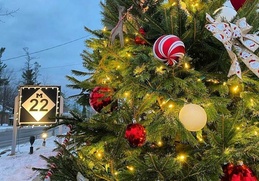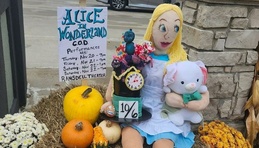
Radical Responsibility
Jamie John on what artists owe themselves and the world
By Anna Faller | Nov. 15, 2025
“Artists have a responsibility to reflect the times that we’re living in,” says northern Michigan artist Jamie John (he/they). “Print-making is entrenched in a radical history. I consider myself to be one of the newer additions to that, and I’m taking up that responsibility in the ways that I know how.”
For the Anishinaabe two-spirit, queer and trans, and Korean-American artist, art has never been just about “pretty pictures.” Instead, he says, art is about cultural connection. It’s about asking questions, sharing lived experiences, and urging audiences to take action to enact the change they’d like to see.
Grief & Experience
John’s artistic journey began with grief. One of his earliest artistic memories surrounds the death of his maternal grandfather and his subsequent enrollment in art therapy courses through the Traverse Area District Library.
“That’s when I was first introduced to woodcut; when I [started] building those habits of painting and drawing and filling my days with making things,” he says.
John, however, was no stranger to loss, even as an elementary schooler.
“Growing up in the tribal community [of the Grand Traverse Band of Ottawa and Chippewa Indians], a huge portion of our life is grief,” he explains. That grief is rooted in the deaths of community members, as well as the loss of cultural pillars like ancestral land and language.
Consequently, John recognized art as a means of understanding and transforming big emotions like grief early on.
“Making things to relay a lived experience [means] that I’m not only leaving something physical behind, but also a story. Folks can look at [my art] and think about what it means to me, the maker, but also to them,” he says.
Since those early days, he’s amassed numerous accolades, including a 2023 Trans Possibilities Initiative Sundance fellowship and a 2025 residency at The Aquarium Gallery in New Orleans. John is also a commissioned artist for upcoming TART Trail signage and a recent participant in Traverse City’s inaugural Mural Festival.
Culture & Blocks
A 2019 graduate of the Interlochen Center for the Arts, John’s body of work spans various media, including collage, zines, watercolor (he even thought he’d become a painter at one point), and public art and printmaking—in particular, relief, aka, block printing, which he highlights as his preferred and primary medium.
If you’re unfamiliar, “block printing” refers to an image creation technique wherein a material block—of linoleum, rubber, or in John’s case, wood—is carved, then inked or painted, and finally pressed to a surface, which transfers the design. It’s easily repeatable, which makes it an ideal vehicle for communication, notes John.
Block printing is also accessible to a degree that other forms of art often are not. The repeatability that block printing provides allows John to keep the bulk of his prices at around $60 per print or below. This, he adds, is intentional, as the goal is not only to increase his overall viewership, but also to get his work into as many hands and homes as possible.
Then, there are the multiple levels of cultural connection the medium provides. Block printing is an ancestral Anishinaabe practice and a symbol of oral tradition—just like storytelling, he says, each piece is an original. John is also Korean-American, linking him to the east Asian-inspired print materials, like Kozo or mulberry paper. (Did you know Korea built one of the first printing presses outside of Germany?)
“It’s an ancestral citation in that way, too,” John adds. “Thinking about other Korean printmakers, even when our materials adapt, our processes stay very similar in terms of what I’m thinking about when I go to make something.”
Perhaps most importantly, John’s chosen medium provides a creative alternative to traditional indigenous Woodland motifs—a distinctive Anishinaabe style characterized by bold lines, bright colors, and subjects from the natural world—which he didn’t want to limit his subject matter.
“Not only did I know that I could do more, but I [also] know that Anishinaabe people are more than just Woodland art,” John says. “Creative process demands dignity and respect to be seen as a person, and I was sick of the expectation that [Woodland] art was all I could do as an Anishinaabe artist.”
Global Thinking & Humanity
Instead, John finds himself most inspired to create based on global events and politics. With that comes the responsibility to voice radical thought and dissent, which John admits can be scary, but that fear just drives him more.
Examples of his latest work include coverage of national ICE raids, especially in urban hubs, like Los Angeles and Grand Rapids (John’s interpretation of which inspired his No Borders! No Raids! and Abolish I.C.E! prints), the dehumanization of immigrants, and America’s involvement in the Israel-Palestine conflict. John was even in Seattle during recent talks of deploying the National Guard.
John has devised a style that mimics the inviting and eye-drawing properties of the Woodland art tradition (think: defined shapes and intricate details) to emphasize and comment on some of the decade’s most contentious issues. The goal here, he says, is to prompt viewers to ask questions and “dig deeper” into the experience each piece depicts, a concept that also resonates throughout John’s more traditionally indigenous imagery, like the colorful Diné Corn Girl, We Are Everywhere (a Brooklyn brownstone relief), or the symbolically-fluid gradient of his My Gender is Two Spirit/Gender Transitions are Sacred diptych.
“No one can really dictate or refute my lived experience, because I lived it,” he says. “So, a question I think about when I’m making an image is who it humanizes and how that connects in broader terms of national and global thinking.”
Reframing & Refusing
Throughout his work, John encourages viewers to reframe perspectives, or refuse to accept the old stories and stereotypes we’ve been told.
“This is all very much influenced by the fact that I experience gender and queerness differently. Refusal to participate in the colonial project that is meant to assimilate me”—whether that applies to gender, race, language, etc.—“is something that people over and over have done in ways that meant that I could be here,” John notes.
John says we can walk away from people and situations that don’t align with our values. We can refuse to engage with systems that perpetuate oppression of the working class, indigenous cultures, the queer community, and beyond. And we can support other people that might lack the resources to do those things.
It’s this sense of empowerment, of taking action, that John hopes audiences draw from his work.
“I want you to think about what you can do to alleviate [others’] suffering, to bring attention to it or disrupt it, rather than feeling like there’s nothing we can do,” he concludes. “I think the worst thing would be to feel defeat when our fight isn’t over yet.”
Find Jamie John’s work at jamierjohn.com
Trending

Strolling Lights, Feeding Neighbors
Help those in need by decorating a tree at the fifth annual Strolling Lights Festival in Glen Arbor! By sponsoring a tree fo… Read More >>
Off to Wonderland in Manistee
Fresh off the spooky fun of It Was a Dark and Stormy Night, and acting as the bridge between that show from the Manistee Civ… Read More >>
Affordable Menstrual Products Up North
Northwestern Michigan College health science student Zinnia Burks wants to understand the prevalence of “period povert… Read More >>


